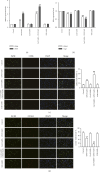Kupffer-Cell-Targeted Carboxylesterase 1f Knockdown Deteriorates Lipopolysaccharide/D-Galactosamine-Induced Acute Liver Failure Through Regulating Cellular Polarization in Mice
- PMID: 39734640
- PMCID: PMC11681982
- DOI: 10.1155/cjgh/6410484
Kupffer-Cell-Targeted Carboxylesterase 1f Knockdown Deteriorates Lipopolysaccharide/D-Galactosamine-Induced Acute Liver Failure Through Regulating Cellular Polarization in Mice
Abstract
Background: Aims: Carboxylesterase (Ces)1f is implicated in protection against hepatic inflammation, but it is unclear whether the enzyme has an influence in polarization of Kupffer cells (KCs), the innate immune cells mediating hepatic inflammatory injury including acute liver failure (ALF). In the present study, we aim to explore KC polarization induced by Ces1f in mice with lipopolysaccharide/D-galactosamine (LPS/D-GalN)-induced ALF. Methods: We adopted a novel delivery system, β-1,3-D-glucan-encapsulated Endoporter-siRNA particles, to specifically target KC Ces1f knockdown via tail vein injection in mice. Results: Ces1f knockdown increased LPS/D-GalN-induced lethality as well as serum levels of alanine and aspartate transaminases, deteriorated hepatic inflammatory injury, and imbalanced hepatic oxidative stress molecules including myeloperoxidase, malondialdehyde, and superoxide dismutase in ALF. Ces1f knockdown also increased the levels of proinflammatory cytokines (tumor necrosis factor-α and interleukin-6) and decreased the levels of anti-inflammatory cytokine (interleukin-10) in LPS/D-Gal-induced ALF. Ces1f knockdown promoted KC M1 phenotype and marker expression (including CD86 and interleukin-1β), but inhibited M2 phenotype and marker expression (including CD163, CD206, and Arginase 1). Conclusions: Our results suggest that Ces1f plays a hepatoprotective role through regulating KC polarization, which might contribute to anti-inflammatory and antioxidative effects in LPS/D-Gal-induced ALF mice.
Keywords: Kupffer cells; acute liver failure; carboxylesterase 1f; gene knockdown; polarization phenotype.
Copyright © 2024 Sai Zhao et al.
Conflict of interest statement
The authors declare no conflicts of interest.
Figures








Similar articles
-
[Effects of in vivo targeted carboxylesterase 1f gene knockdown on the Kupffer cells polarization activity in mice with acute liver failure].Zhonghua Gan Zang Bing Za Zhi. 2023 Jun 20;31(6):582-588. doi: 10.3760/cma.j.cn501113-20220330-00151. Zhonghua Gan Zang Bing Za Zhi. 2023. PMID: 37400381 Chinese.
-
Mangiferin Attenuates LPS/D-GalN-Induced Acute Liver Injury by Promoting HO-1 in Kupffer Cells.Front Immunol. 2020 Feb 25;11:285. doi: 10.3389/fimmu.2020.00285. eCollection 2020. Front Immunol. 2020. PMID: 32158448 Free PMC article.
-
Salvage effect of E5564, Toll-like receptor 4 antagonist on d-galactosamine and lipopolysaccharide-induced acute liver failure in rats.J Gastroenterol Hepatol. 2010 May;25(5):1009-12. doi: 10.1111/j.1440-1746.2009.06145.x. J Gastroenterol Hepatol. 2010. PMID: 20546456
-
Protective Role of 4-Octyl Itaconate in Murine LPS/D-GalN-Induced Acute Liver Failure via Inhibiting Inflammation, Oxidative Stress, and Apoptosis.Oxid Med Cell Longev. 2021 Aug 17;2021:9932099. doi: 10.1155/2021/9932099. eCollection 2021. Oxid Med Cell Longev. 2021. PMID: 34457120 Free PMC article.
-
Hepatoprotective effect of α-mangostin against lipopolysaccharide/d-galactosamine-induced acute liver failure in mice.Biomed Pharmacother. 2018 Oct;106:896-901. doi: 10.1016/j.biopha.2018.07.034. Epub 2018 Jul 12. Biomed Pharmacother. 2018. PMID: 30119260
Cited by
-
Advances in Understanding Lipopolysaccharide-Mediated Hepatitis: Mechanisms and Pathological Features.Curr Issues Mol Biol. 2025 Jan 27;47(2):79. doi: 10.3390/cimb47020079. Curr Issues Mol Biol. 2025. PMID: 39996800 Free PMC article. Review.
References
-
- Tian L., Li W., Yang L., et al. Cannabinoid Receptor 1 Participates in Liver Inflammation by Promoting M1 Macrophage Polarization via RhoA/NF-Κb P65 and ERK1/2 Pathways, Respectively, in Mouse Liver Fibrogenesis. Frontiers in Immunology . 2017;8:p. 1214. doi: 10.3389/fimmu.2017.01214. - DOI - PMC - PubMed
Publication types
MeSH terms
Substances
LinkOut - more resources
Full Text Sources
Research Materials

